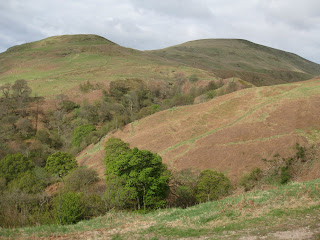This has not been a classic May so far, weather-wise, on the Misty Isle. But it was OK for my return last week when the highlight of the week was meeting up with the Quinn brothers, Michael and Chris who were closing in on their last 4 Cuillin Munros. Having warmed up on the Five Sisters of Kintail, they met up with me at Glen Brittle Youth Hostel where we decided which of the 4 remaining peaks the conditions would lend themselves to. In the event, we elected for the relatively safe route up into Coire a' Ghreadaidh to climb the 2 central peaks of Sgurr a' Mhadaidh and Sgurr a' Ghreadaidh.
 Coire a' Ghreadaidh
Coire a' GhreadaidhThe path leads up alongside the delightful waterfalls and rock pools that the Allt a' Choire Ghreadaidh has created to add interest to its relentless journey down the mountainside to the sea. Louseworts and milkworts provided some rare colour by the path but there was no sign of the golden eagle sighting I had rashly promised Michael. A passing shower dampened only the gore-tex as our spirits remained high given the rapid progress this route makes up on to the higher ground. You might expect any mountain day with the Irish to be entertaining and the boys didn’t let me down. I now know an awful lot more about the differences between Scottish and Irish Gaelic, how to service a Boeing 737, and the development of Soviet-Irish diplomatic relations, than I did last week! Cloud shrouded the ridgeline and did so for much of the day but we could clearly see our route up on to the scree and into our gateway to the skyline: An Dorus (the door), a sharp defile that provides a rare access route on to the main Cuillin ridge.
 An Dorus
An DorusWhilst An Dorus itself is easily attained, it takes a tricky rock step to climb out of it on either side and a steady head – and hold or two – is required to make onward progress. One of these can be avoided on the left by leaving the gulley about 20m below the ridge and working your way up shaley ledges before scrambling up on to the rather anti-climactic summit of Sgurr a’ Mhadaidh (918m; peak of the foxes). Just north of this summit the Cuillin ridge makes a 90 degree turn eastwards before continuing on to the northern peaks that culminate in the shapely spire of Sgurr nan Gillean. The only view we got today was of the day’s other objective: one of the Cuillin’s finest peaks: Sgurr a’ Ghreadaidh. We returned to An Dorus the same way thus avoiding one difficult step; but there was no escaping the second one which gets you on your way southwards.
Soon after leaving An Dorus you come across the rock crevice of Eag Dubh (black notch) which has been sliced out of the ridge and is narrow enough to give an Asda shopper a tight squeeze. It can however be avoided to the left and the ridge is again followed up past the Wart, an impressive prow of gabbro which appears to block the way from a distance but is in fact easily passed to the right.
A little after this the ridge narrows and a diminutive summit cairn marks the northern and highest summit of Sgurr a' Ghreadaidh (973m; peak of torment). The summit ridge of this fine mountain forms a twin-peaked sharp ridge which is the narrowest rock arête in Britain. Nowhere is it technically difficult but a steady head and sure foot is required throughout and the traverse of the mountain is totally absorbing. Do it on a fine day when this aerial walkway will give you one of your most memorable UK mountain experiences – but do it!

If you decide to continue south from here, as I did earlier in the week, there are no escape routes off the ridge for some way so be warned. The ridge continues south-west from Sgurr a' Ghreadaidh past the rock pinnacles of the Three Teeth and over the cone of Sgurr Thormaid to the next Munro: Sgurr na Banachdich. Further on again and you come to Sgurr Dearg and its iconic summit prominence, the Inaccessible Pinnacle (which loomed out of the mist and was deserted today). You can then escape westwards down a good path back to Glen Brittle.

Today, however, the 3 of us returned to An Dorus and successfully negotiated the difficult step and made good our descent back the way we had come. One brief shower on the way down but still no golden eagles! The next day Michael and Chris endured a magnificent 10-hour day and secured their last 2 Cuillin Munros. Job done – as they say in Ireland! I bet some Guinness was downed that night....












